Pu Sun
Data-Centric Learning Framework for Real-Time Detection of Aiming Beam in Fluorescence Lifetime Imaging Guided Surgery
Nov 11, 2024



Abstract:This study introduces a novel data-centric approach to improve real-time surgical guidance using fiber-based fluorescence lifetime imaging (FLIm). A key aspect of the methodology is the accurate detection of the aiming beam, which is essential for localizing points used to map FLIm measurements onto the tissue region within the surgical field. The primary challenge arises from the complex and variable conditions encountered in the surgical environment, particularly in Transoral Robotic Surgery (TORS). Uneven illumination in the surgical field can cause reflections, reduce contrast, and results in inconsistent color representation, further complicating aiming beam detection. To overcome these challenges, an instance segmentation model was developed using a data-centric training strategy that improves accuracy by minimizing label noise and enhancing detection robustness. The model was evaluated on a dataset comprising 40 in vivo surgical videos, demonstrating a median detection rate of 85%. This performance was maintained when the model was integrated in a clinical system, achieving a similar detection rate of 85% during TORS procedures conducted in patients. The system's computational efficiency, measured at approximately 24 frames per second (FPS), was sufficient for real-time surgical guidance. This study enhances the reliability of FLIm-based aiming beam detection in complex surgical environments, advancing the feasibility of real-time, image-guided interventions for improved surgical precision
Active Fake: DeepFake Camouflage
Sep 05, 2024
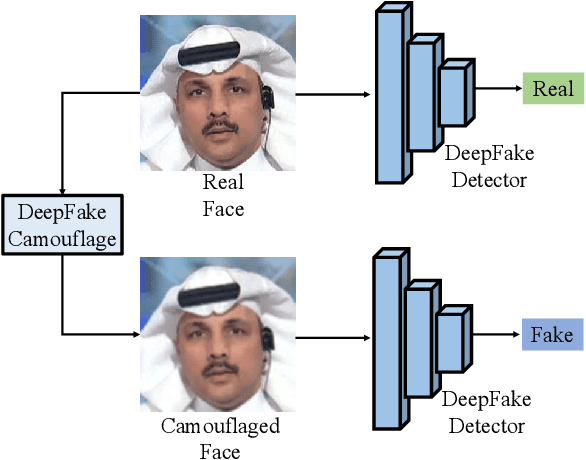
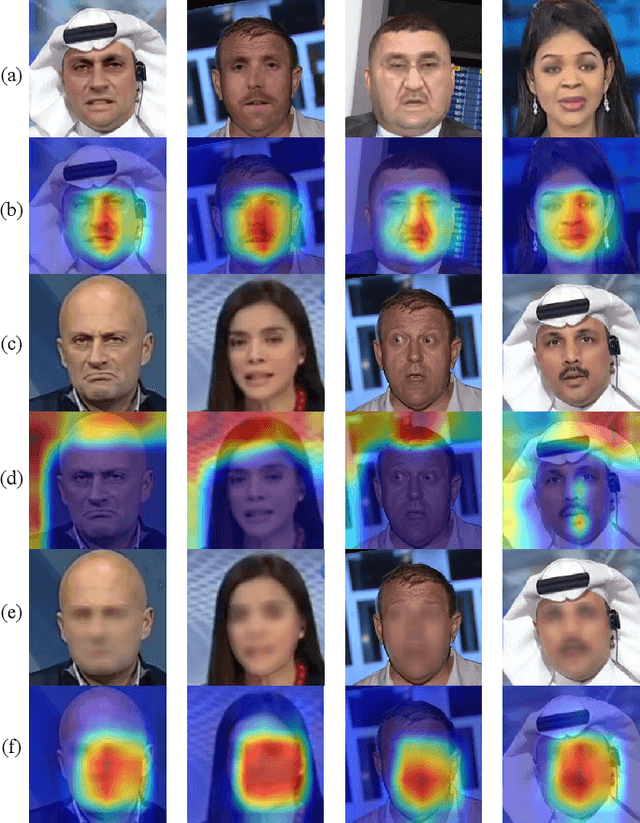
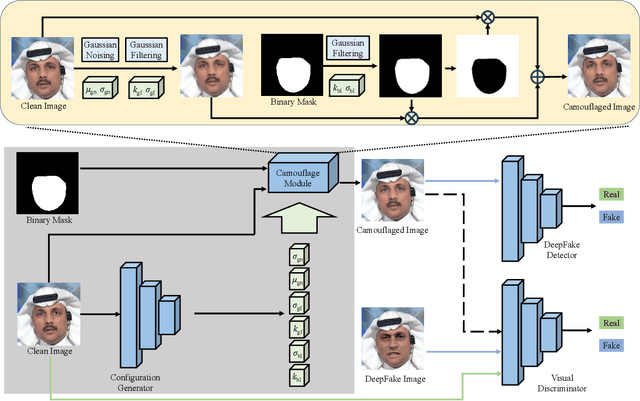
Abstract:DeepFake technology has gained significant attention due to its ability to manipulate facial attributes with high realism, raising serious societal concerns. Face-Swap DeepFake is the most harmful among these techniques, which fabricates behaviors by swapping original faces with synthesized ones. Existing forensic methods, primarily based on Deep Neural Networks (DNNs), effectively expose these manipulations and have become important authenticity indicators. However, these methods mainly concentrate on capturing the blending inconsistency in DeepFake faces, raising a new security issue, termed Active Fake, emerges when individuals intentionally create blending inconsistency in their authentic videos to evade responsibility. This tactic is called DeepFake Camouflage. To achieve this, we introduce a new framework for creating DeepFake camouflage that generates blending inconsistencies while ensuring imperceptibility, effectiveness, and transferability. This framework, optimized via an adversarial learning strategy, crafts imperceptible yet effective inconsistencies to mislead forensic detectors. Extensive experiments demonstrate the effectiveness and robustness of our method, highlighting the need for further research in active fake detection.
An Adaptive Tensor-Train Decomposition Approach for Efficient Deep Neural Network Compression
Aug 02, 2024



Abstract:In the field of model compression, choosing an appropriate rank for tensor decomposition is pivotal for balancing model compression rate and efficiency. However, this selection, whether done manually or through optimization-based automatic methods, often increases computational complexity. Manual rank selection lacks efficiency and scalability, often requiring extensive trial-and-error, while optimization-based automatic methods significantly increase the computational burden. To address this, we introduce a novel, automatic, and budget-aware rank selection method for efficient model compression, which employs Layer-Wise Imprinting Quantitation (LWIQ). LWIQ quantifies each layer's significance within a neural network by integrating a proxy classifier. This classifier assesses the layer's impact on overall model performance, allowing for a more informed adjustment of tensor rank. Furthermore, our approach includes a scaling factor to cater to varying computational budget constraints. This budget awareness eliminates the need for repetitive rank recalculations for different budget scenarios. Experimental results on the CIFAR-10 dataset show that our LWIQ improved by 63.2$\%$ in rank search efficiency, and the accuracy only dropped by 0.86$\%$ with 3.2x less model size on the ResNet-56 model as compared to the state-of-the-art proxy-based automatic tensor rank selection method.
FakeTracer: Proactively Defending Against Face-swap DeepFakes via Implanting Traces in Training
Jul 27, 2023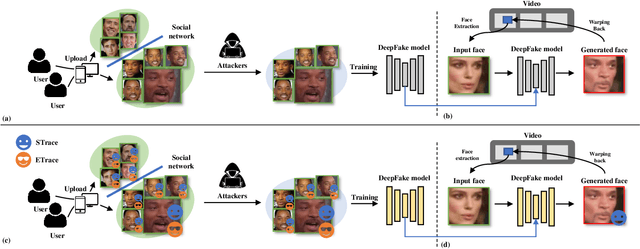


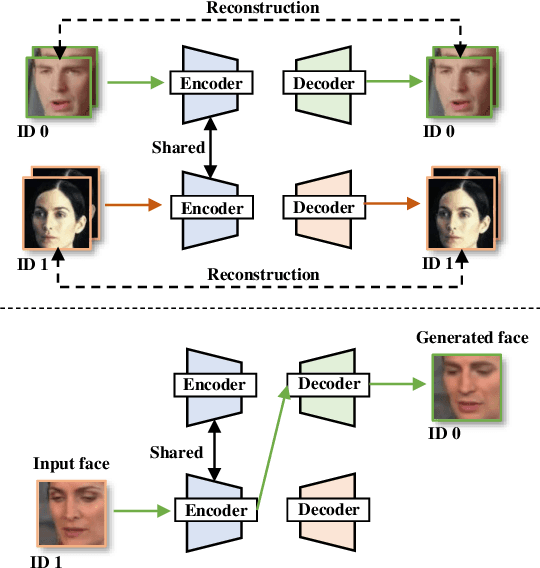
Abstract:Face-swap DeepFake is an emerging AI-based face forgery technique that can replace the original face in a video with a generated face of the target identity while retaining consistent facial attributes such as expression and orientation. Due to the high privacy of faces, the misuse of this technique can raise severe social concerns, drawing tremendous attention to defend against DeepFakes recently. In this paper, we describe a new proactive defense method called FakeTracer to expose face-swap DeepFakes via implanting traces in training. Compared to general face-synthesis DeepFake, the face-swap DeepFake is more complex as it involves identity change, is subjected to the encoding-decoding process, and is trained unsupervised, increasing the difficulty of implanting traces into the training phase. To effectively defend against face-swap DeepFake, we design two types of traces, sustainable trace (STrace) and erasable trace (ETrace), to be added to training faces. During the training, these manipulated faces affect the learning of the face-swap DeepFake model, enabling it to generate faces that only contain sustainable traces. In light of these two traces, our method can effectively expose DeepFakes by identifying them. Extensive experiments are conducted on the Celeb-DF dataset, compared with recent passive and proactive defense methods, and are studied thoroughly regarding various factors, corroborating the efficacy of our method on defending against face-swap DeepFake.
DeepFake-o-meter: An Open Platform for DeepFake Detection
Mar 02, 2021
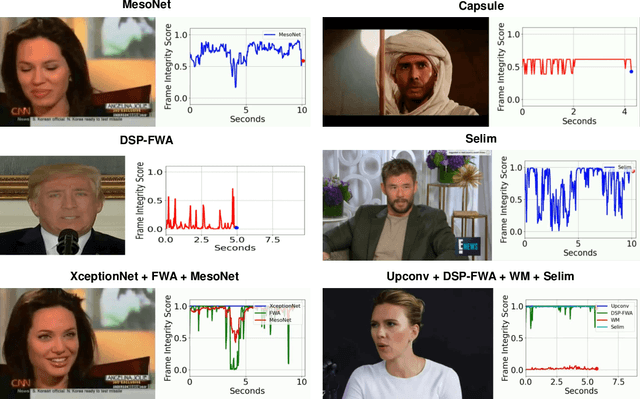
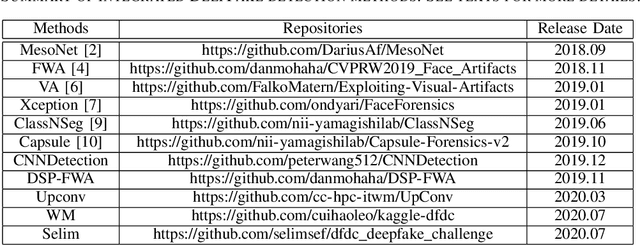
Abstract:In recent years, the advent of deep learning-based techniques and the significant reduction in the cost of computation resulted in the feasibility of creating realistic videos of human faces, commonly known as DeepFakes. The availability of open-source tools to create DeepFakes poses as a threat to the trustworthiness of the online media. In this work, we develop an open-source online platform, known as DeepFake-o-meter, that integrates state-of-the-art DeepFake detection methods and provide a convenient interface for the users. We describe the design and function of DeepFake-o-meter in this work.
Landmark Breaker: Obstructing DeepFake By Disturbing Landmark Extraction
Feb 01, 2021
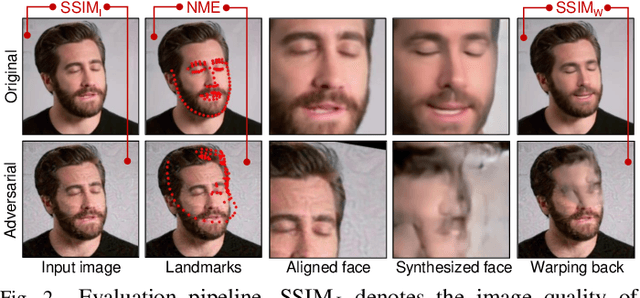
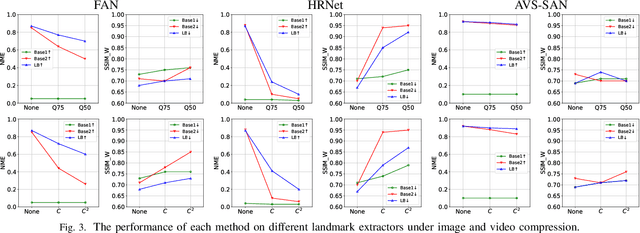

Abstract:The recent development of Deep Neural Networks (DNN) has significantly increased the realism of AI-synthesized faces, with the most notable examples being the DeepFakes. The DeepFake technology can synthesize a face of target subject from a face of another subject, while retains the same face attributes. With the rapidly increased social media portals (Facebook, Instagram, etc), these realistic fake faces rapidly spread though the Internet, causing a broad negative impact to the society. In this paper, we describe Landmark Breaker, the first dedicated method to disrupt facial landmark extraction, and apply it to the obstruction of the generation of DeepFake videos.Our motivation is that disrupting the facial landmark extraction can affect the alignment of input face so as to degrade the DeepFake quality. Our method is achieved using adversarial perturbations. Compared to the detection methods that only work after DeepFake generation, Landmark Breaker goes one step ahead to prevent DeepFake generation. The experiments are conducted on three state-of-the-art facial landmark extractors using the recent Celeb-DF dataset.
LandmarkGAN: Synthesizing Faces from Landmarks
Oct 31, 2020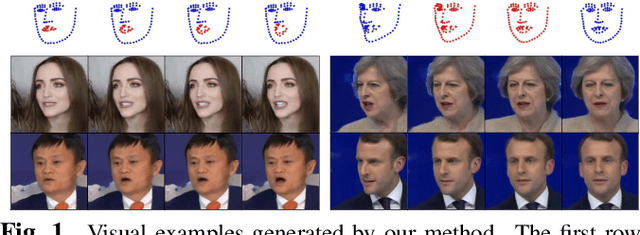
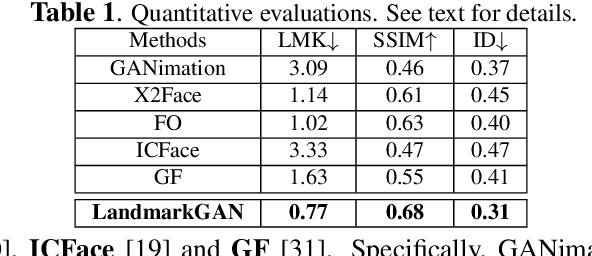

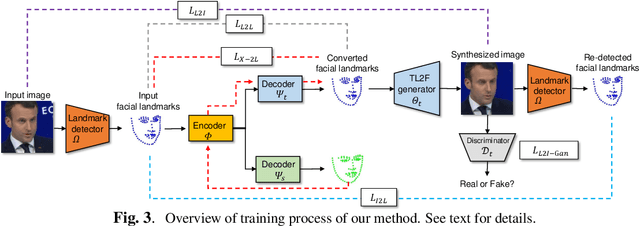
Abstract:Face synthesis is an important problem in computer vision with many applications. In this work, we describe a new method, namely LandmarkGAN, to synthesize faces based on facial landmarks as input. Facial landmarks are a natural, intuitive, and effective representation for facial expressions and orientations, which are independent from the target's texture or color and background scene. Our method is able to transform a set of facial landmarks into new faces of different subjects, while retains the same facial expression and orientation. Experimental results on face synthesis and reenactments demonstrate the effectiveness of our method.
Celeb-DF: A New Dataset for DeepFake Forensics
Oct 02, 2019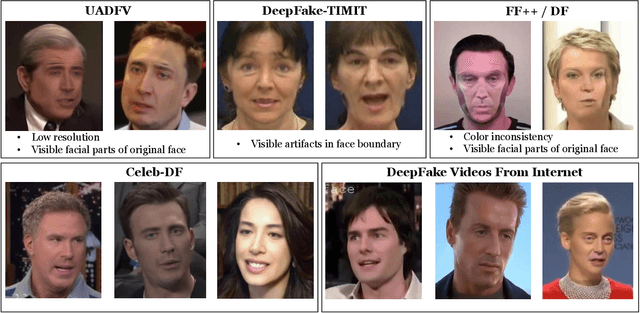
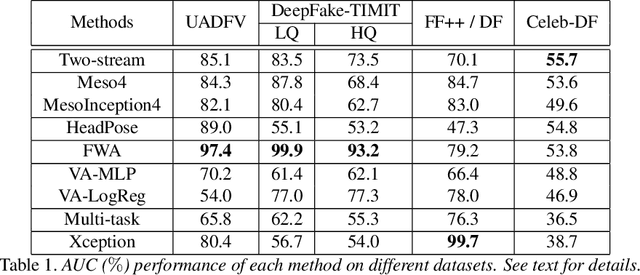
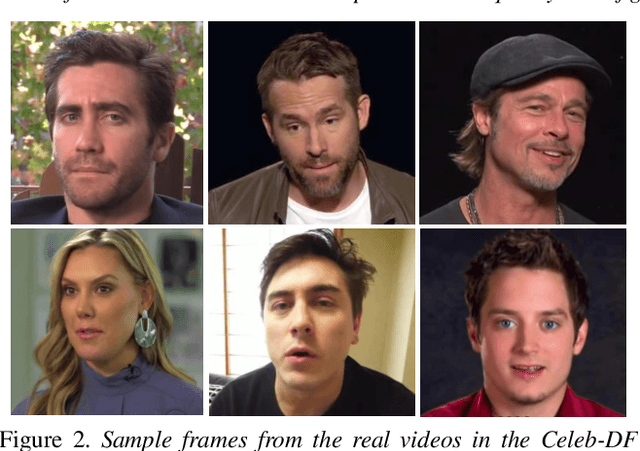
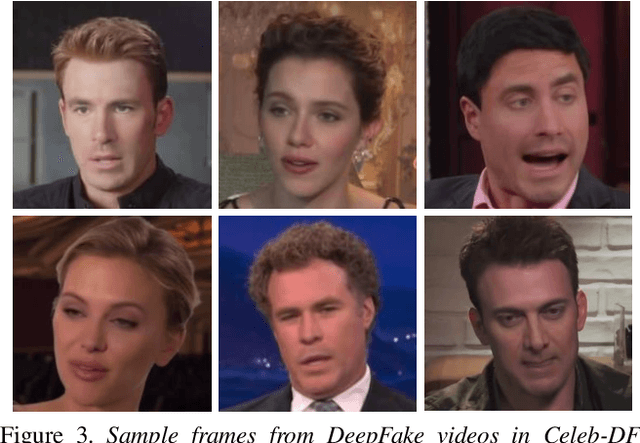
Abstract:AI-synthesized face swapping videos, commonly known as the DeepFakes, have become an emerging problem recently. Correspondingly, there is an increasing interest in developing algorithms that can detect them. However, existing dataset of DeepFake videos suffer from low visual quality and abundant artifacts that do not reflect the reality of DeepFake videos circulated on the Internet. In this work, we present a new DeepFake dataset, Celeb-DF, for the development and evaluation of DeepFake detection algorithms. The Celeb-DF dataset is generated using a refined synthesis algorithm that reduces the visual artifacts observed in existing datasets. Based on the Celeb-DF dataset, we also benchmark existing DeepFake detection algorithms.
 Add to Chrome
Add to Chrome Add to Firefox
Add to Firefox Add to Edge
Add to Edge